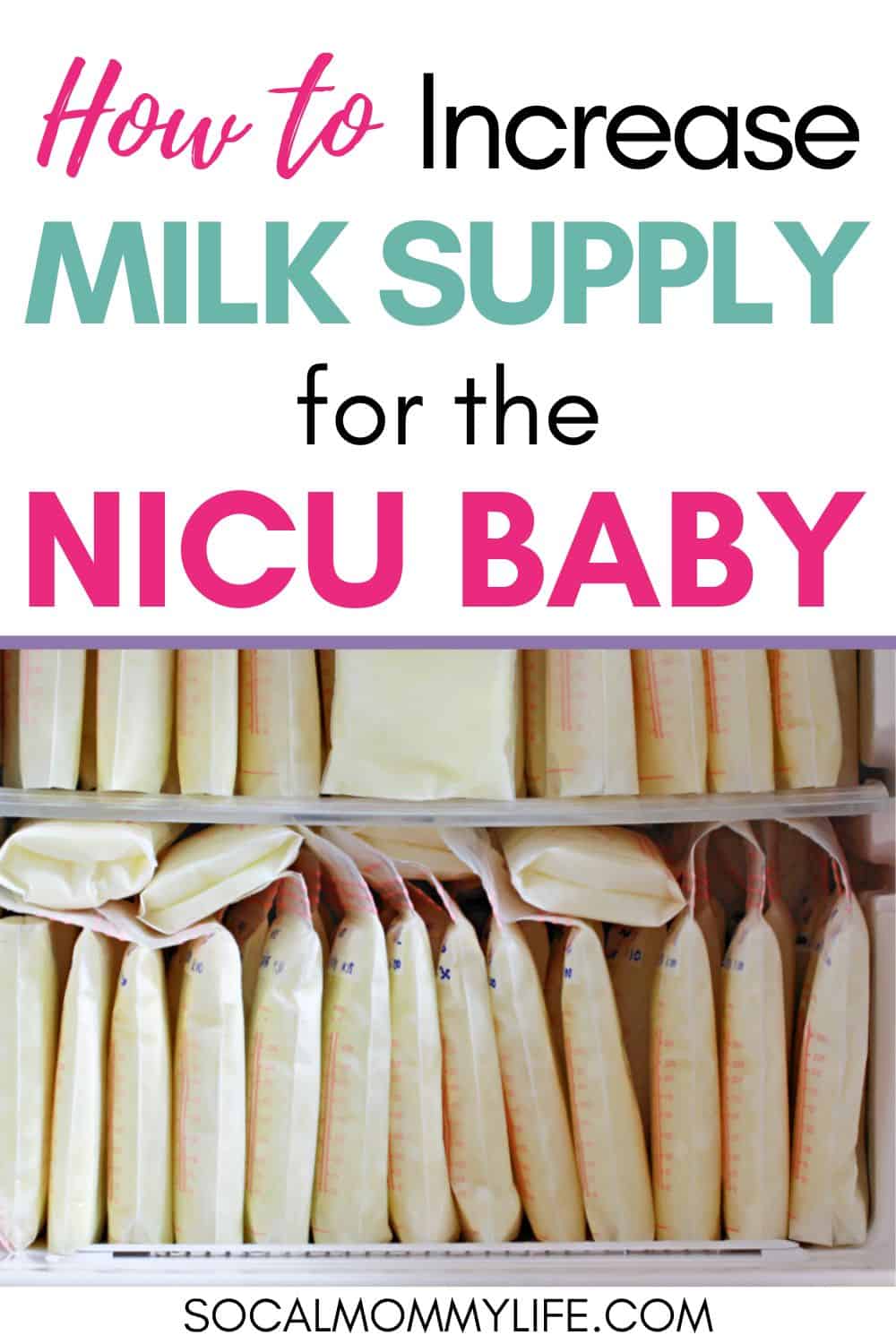Nurse, what can I do now that my baby is in the NICU?
Me
The best thing you can do for your baby is to start pumping for milk!
Nurse
These were the exact words exchanged with the nurse when Baby Chunbao was first admitted to the NICU.
I was horrendous, worried, and lost.
I didn’t get to see my new baby (Chunbao was immediately transferred to the Children’s Hospital) and now you’re telling me to hook up my breasts to a cold machine? I dreaded it, but pumping was really the only thing I could do during the first couple of NICU days and I’m glad I did just that.
This post may contain affiliate links, which means I’ll receive a commission if you purchase through my link, at no extra cost to you. Please read full disclosure here.
Importance of breast milk for a NICU baby
Regardless of what made your baby whisked away to the NICU, breast milk is the optimal food. It has infection-fighting antibodies not found in formula that prevent the baby from getting sick.
Breast milk contains just the right amount of nutrients to help the baby grow and develop.
For a low birth weight baby like my son, fortified breast milk may be fed in order to make the breast milk more caloric. Baby Chunbao was being fed my fortified breast milk through the feeding tube for almost 6 weeks in the NICU.
He didn’t need a lot of milk, due to his very low birth weight, so I was able to pump up a mini freezer stash for him as he grows bigger.
How to increase milk supply when baby is in the NICU
Building breastmilk supply is hard work, especially having to deal with the emotional and physical stress a NICU baby can bring.
However, for me, having a sick baby gave me the extra willpower to pump.
Be sure to take good care of your body by following this postpartum care plan if you have a vaginal delivery.
Building up milk supply does not happen overnight. It is a process that takes persistence and determination. Once I have that goal in mind, below are the 13 things I’ve done to boost (and maintain) my milk supply.
Tip #1: Get a good double electric breast pump
If you’re wondering how to get milk to come in when baby is in the NICU, the answer is you need to start pumping.
Since your baby is unable to breastfeed, you need to do whatever you can to express your breastmilk.
Double electric pumps offer the convenience of time-saving by pumping both breasts at the same time. You also want to choose a good pump to effectively drain the breasts.
The NICU most likely has hospital-grade pumps for moms to use while visiting the baby so we mommies don’t need to haul our own pump when we visit. The golden standard of hospital-grade pumps is the Medela Symphony breast pump. Looks familiar?
I was using the Medela Symphony pump at the NICU and switched to the Spectra S2 electric pump at home. I noticed a difference in supply output because the Medela is just a lot more powerful than my Spectra pump. The very next day, I went ahead and rented a Medela Symphony pump so I could use it at home.
The Medela Symphony pump is a $2000 beast so it’s just better for our wallets to rent it. Some hospitals loan pumps so call your hospital if you need to rent one. I rent mine at a local mother/baby shop at a cheaper price. So, check and see if your nearby baby store offers the pump for rent!
Tip #2: Listen to hypnotizing music
For 2 days postpartum, I religiously pumped every 2.5 hours for at least 15 minutes. Nothing came out. My nipples were as dry and cracked as ever. I scoured all over the internet looking for pumping tips and came across this hypnosis for breastfeeding.
I’m not a meditation soul, nor a believer in hypnosis. However, I found this guided meditation music very relaxing. My milk started to come in soon after I started listening to this video when I pumped.
Tip #3: Drink Mother’s Milk Women’s Tea
Every one of my mama friends drank the Mother’s Tea for milk supply so undoubtedly, I stocked them when I was still pregnant.
The organic tea blend contains milk-boosting herbs such as fennel and fenugreek.
I usually brew a tea bag and sip it throughout the day when visiting my baby in the NICU. I found the tea pleasant by itself but sometimes, I add a bit of honey to sweeten it up. On occasion, I would drink it again after I get home from the hospital.
RELATED POST: 5 Incredible Mother’s Milk Tea Benefits: Discover Why Nursing Moms Swear By It
Tip #4: Pumping schedule to produce more breast milk
Milk supply is based on a supply-and-demand basis. The more you pump (emptying your breasts), the more your breasts will produce milk.
Some key points to keep in mind:
- Pump as often as baby would be eating (every 2 to 3 hours).
- It’s hard, but try to pump at least twice during the night.
- Pump for around 15 to 20 minutes each session.
- Pump for 2 additional minutes after breastmilk has stopped flowing. Do not overpump.
- Don’t give up pumping until your supply is established. It could take anywhere from 6 to 12 weeks until your milk supply is well established. When you see a drop in supply, increase pumping frequency until your supply is back up again.
Power pumping is another pumping technique moms often do to increase milk production. The rationale behind it also based on supply-and-demand by repeatedly emptying breast milk and signaling the body to produce more milk quickly.
It takes 1 hour to do so with the schedule as such: Double pump for 20 minutes, rest for 10 minutes, pump for 10 minutes, rest for 10 minutes, pump for 10 minutes.
Here is my typical pumping schedule while Baby Chunbao was in the NICU.

Tip #5: Massage breasts while you pump
In my post on surviving the NICU, I mentioned massaging the breasts while pumping in order to get more breast milk out.
It was very noticeable that more milk streaked out when I applied pressure to my breasts while pumping. Watch this video on how to do hands-free massage. you’ll also need a hands-free pumping kit in order to effectively massage breasts while pumping.
Tip #6: Use fenugreek supplement to overcome low milk supply
This milk-boosting powerhouse is a must for any mom looking to increase her milk production.
Fenugreek has been used for centuries as a galactagogue. Although a few studies have shown mixed results, I personally find it effective in boosting my milk supply.
I religiously took 2 capsules with every meal and noticed an increase in milk production within days. By the way, I choose Nature’s Way brand because they are reputable and non-GMO.
Tip #7: How to resolve plugged ducts fast
Plugged ducts usually feel like hard tender swelling in the breast that can sometimes be painful. If left untreated, clogged ducts may lead to mastitis which is a nasty infection that requires hospitalization.
Plugged ducts happen with poor milk drainage from the breasts. If milk is not drained completely, how do you expect our breasts to produce more milk?
So, plugged ducts require immediate attention so that it doesn’t hurt our milk supply.
The number one thing to resolve plugged ducts is to apply moist heat to the breast. The moment you feel those lumps in your breasts apply a heated towel to your breasts for a minute or two before pumping.
How I manage to do this in the NICU?
I bought two small towels and a Tupperware for the hospital. Prior to visiting my son’s room, I fill the Tupperware (with the towels inside) with hot water from the NICU breakroom. Close the Tupperware lid and off we go to see our son.
I tried my best to wring the towels from the hot water and apply them to my breasts.
Tip #8: Lecithin supplement
Even with all that pumping, I tend to get recurrent clogged ducts easily.
Besides applying a heated towel and massaging my breasts prior to pumping, I also took lecithin every day. Lecithin lessens the thickness of breast milk, allowing the milk to flow more easily.
For plugged ducts, it is recommended to take 3600-4800 mg lecithin per day for 3-4 times a day. If plugged ducts are resolved, lecithin intake can be reduced to 1 time a day.
I did notice my plugged ducts went away when I took it and came back on the days I didn’t take it. The effect is pretty significant!
If you are worried about side effects, lecithin is a common food additive so it’s completely safe for breastfeeding/pumping moms. As with any nutritional supplement, do not take more than the recommended dose.
Tip #9: Eat a protein-rich diet
The mechanism of breast milk production requires a lot of energy from the body. Every ounce of breast milk burns about 20 calories!
What’s more to supplement that burnt calories? Proteins.
Our Children’s Hospital offers 1 free meal a day for breastfeeding/pumping moms so I took total advantage of that. The menu offers a variety of proteins such as turkey sandwiches, omelets, chili, mac n cheese, pasta, etc.
Ensure to incorporate lots of protein either from meat or vegetable sources like beans and legumes in every meal. You may also feel hungry more often because of all the burnt calories from pumping and breastfeeding. Great choices of snacks to munch on between meals are nuts, hard-boiled eggs, and protein bars.
These organic vegan protein bars from Orgain are not only yummy but each bar contains 10 grams of clean protein.
Tip #10: Drink lots of water
Water is the main ingredient in breast milk so no water, no breast milk.
It’s easy to forget drinking water with all that traveling to the hospital, kangaroo care, getting updates on your baby’s health, pumping, and the list goes on…
To ensure that I get at least 64 ounces of water a day, I got myself a 50oz tumbler to sip throughout the day. With this tumbler, I know that I need one and a half bottles full of water to meet my daily quota.
Tip #11: Drink lots of bone soup
In Traditional Chinese Medicine dated more than 3000 years back, bone soup, especially whole fish soup in combination with certain foods, is said to boost milk supply.
It is a popular Asian practice that new moms to drink bone soup every day for at least 3 months postpartum.
The idea behind it is that since breast milk is 88% water, drinking bone soup ensures moms get enough water with added proteins and minerals for their milk production. A well-known Asian milk-boosting soup is the pork feet soup.

Nowadays, bone broths are readily available. My favorite is the Kettle and Fire classic chicken bone broth that comes in individual cartons. I just heat it in the hospital’s microwave and I get to enjoy a steamy mug of bone broth in practically no time.
Tip #12: Sports Drink
The rationale behind drinking sports beverages to increase milk production is similar to that of consuming bone soup as I mentioned above. You want to get in as much liquid as possible since breastmilk is 88% water.
The extra minerals and electrolytes in sports beverages like Gatorade and Poweraid add extra nutrients in breast milk production. Myths have it that the red Poweraid is the best amongst sports drinks to boost milk supply so that was what I drank during my baby’s NICU stays.
Tip #13: Drink collagen-rich fish and green papaya soup
Fish and green papaya soup is a well-known breastmilk-boosting soup in Asian culture.
Ingredients: Medium-sized whole fish including head and tail (preferably carp fish), half of a green papaya, ginger slices, handful of peanuts, 4 liters of water, a dash of salt, dates (optional), goji berries (optional).
Note: live whole fish can be easily found in any Asian market.
Directions:
- Clean fish.
- Boil water and add ginger and peanuts.
- Cut the papaya into squares and discard seeds. Add papaya and fish into the boiling pot.
- Add optional dates and goji berries.
- Turn down to low heat and cook covered for 4 hours.
- Add salt to taste prior to serving.
My mom would make a huge pot of the fish and green papaya soup enough for me to consume for 3 days!
Conclusion on how to increase milk supply when baby is in the NICU
It was incredibly difficult for me to pump every 2.5 hours with a baby in the NICU. But, I never strayed away from my determination to pump more milk because I wanted my sick baby to get the best nutrition.
Just believe that you are strong and you can build up an abundant supply of breast milk too.
The hospital’s lactation consultant is a great resource too.
Do you find these tips helpful in increasing your milk supply for your NICU baby? What other tips have you done to overcome low milk supply?
Let me know by leaving a comment below.

Related articles:
- The ultimate guide to surviving the NICU
- How I overcame the NICU mom guilt while surviving the NICU twice
- What you need to do before bringing your baby home from the NICU
- 17 Best Preemie Clothes For NICU That Are Perfect For Your Littlest One
- Best infant toys of all times (updated for 2023)










